|
|
ARTHROPODS:
Insects»
Spiders»
Centipedes»
Millipedes»
Sowbugs»
Harvestmen»
Mites
& Ticks»
Scorpions»
Identification
Tips»
About
the Critter Files»
Links» |
|
|
|
| |
| TAXONOMY |
KINGDOM:
Animalia | PHYLUM: Arthropoda | CLASS: Insecta | ORDER:Coleoptera
| FAMILY: Scarabaeidae | SUBFAMILY: Dynastinae | GENUS and SPECIES:
Dynastes tityus (Eastern Hercules Beetle) |
| |
| Other
Names: Rhinoceros Beetles, Rhino Beetles, Unicorn Beetles,
Horn Beetles, Horned Beetles |
| |
WHAT
IS A HERCULES BEETLE?
LIFE CYCLE
ECOLOGY
PEST STATUS
COLLECTING & PHOTOGRAPHY
REARING INFORMATION
HERCULES BEETLE FACTS
HERCULES BEETLE RELATIVES
HYDRIDIZATION: EASTERN + WESTERN HERCULES BEETLES
HERCULES BEETLE LINKS
MYTHS, LEGENDS, AND FOLKLORE |
| |
| WHAT
IS A HERCULES BEETLE? |
|
Like all
beetles, Hercules Beetles have chewing mouthparts
and hardened front wings (elytra). Hercules beetles are in
the scarab beetle family (Scarabaeidae), which also includes Japanese
Beetles, June Beetles, and Dung Beetles.

Female Eastern Hercules Beetle (B. Wallin, 2003)
The only Hercules beetle
species in Kentucky is the Eastern Hercules Beetle,
Dynastes tityus, which is the largest beetle in this part
of the country. Adult Eastern Hercules Beetles typically have
green, gray, or tan elytra mottled with black spots (rare individuals
lack spots). Click here for a picture
showing color variation among adult Hercules beetles. Adult
male beetles have 2 large horns: 1 on the head and 1 on the thorax.
They also have 2 small horns
located next to the large thorax horn. Females lack horns. |
| |
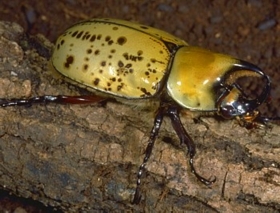
Male Eastern Hercules Beetle
(R. Bessin, 2002) |
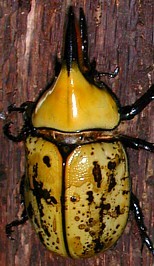
Male Eastern Hercules Beetle
(U. Savali, 2002) |
| |
| The
large larvae, called "grubs", have c-shaped white bodies
and (like all beetle larvae) chewing mouthparts. |
| |
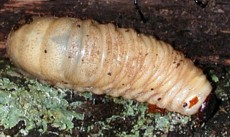
Hercules Beetle Grub
(U. Savali, 2002) |
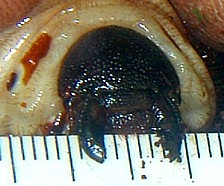
Close-up of grub mouthparts
(B. Wallin, 2003) |
|
| SIZE:
Adult beetles 1 1/2" - 2 1/4"; grubs up to 4 1/2"long
|
| |
| LIFE
CYCLE |
|
|
| Eastern
Hercules Beetles have "complete" metamorphosis with egg,
larval, pupal, and adult stages. Female beetles lay eggs directly
into the soil during warm months. Click here
to see a picture of a Hercules beetle egg.
In about 1 month, the
eggs hatch into larvae. During the next 6 months to 1 year,
the larvae live underground where they grow and molt (shed their
skins) twice before turning into pupae. As with all insects,
each immature stage is called an "instar."
|
| |
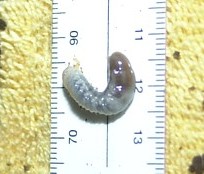
1st instar Hercules beetle larva. (B. Wallin, 2003) |
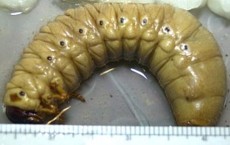
3rd instar Hercules beetle larva - up to 4 1/2" long.
(B. Wallin, 2003) |
| |
| The adults
emerge from pupae after only a few weeks, but will remain underground
until spring. Upon emerging from the ground, females will begin
emitting pheromones to attract male beetles. After mating, females
burrow into the ground to lay eggs. You can see a video (a .wmv file,
which can be viewed with compatible players, such as Windows Media
Player) of Hercules beetles mating at Bill Wallin's homepage.
|
| |
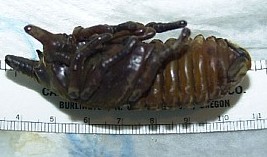
Male Hercules beetle pupa (B. Wallin, 2003) |
| |
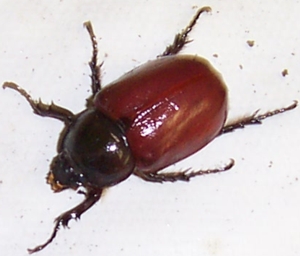
Teneral Female (B. Wallin, 2005) |
| |
| Pictured above
is a "teneral" female Hercules beetle. "Teneral"
refers to the soft-bodied state of an insect just after molting (shedding
its skin). Typically, the teneral state lasts for a few hours
while the cuticle hardens. Insects usually have pale or muted
colors while they are teneral. See more pictures of teneral Hercules beetles here. |
| |
| Male beetles
often use their horns to fight one another for the right to mate with
a female. Click here to see a close-up
of the damage done to one male Hercules beetle by another. You
can also see a movie of male Hercules beetles fighting at Bill Wallin's
homepage. Like
the mating video mentioned above, it is a .wmv movie file. |
| |
| ECOLOGY |
|
| |
Hercules
beetle grubs feed on decaying plant material, especially logs, stumps,
dead leaves, and rotten fruit. Most commonly, they are found
in tree stumps that they have tunneled into from the soil beneath.
The grubs are a food source for skunks, raccoons, and other
mammals, as well as predatory soil-dwelling arthropods like centipedes,
ground beetles, and spiders.
The feeding habits of
the adult beetles are not well-known, but they have been observed
to eat rotten fruit and the bark of ash trees.
There is a mite predator
that feeds on Hercules beetle eggs. It lives in the soil and
is small, white, round, and the same size as a Hercules beetle egg.
Click here for pictures of this mite.
Another grub predator is the Mydas fly maggot, which burrows
through soil and feeds on Hercules beetle grubs. Click here
for a picture of a Mydas fly maggot.
|
| |
| PEST
STATUS |
|
Hercules
beetles are not pests in Kentucky. |
| |
| COLLECTING
& PHOTOGRAPHY |
|
The Eastern Hercules
Beetle is one of the most sought-after insects in Kentucky, and
makes an impressive mounted specimen or photo subject. The
best way to find adult Eastern Hercules Beetles is by using ultraviolet
(UV) lights: like many insects, Hercules beetles are attracted to
UV lights at night. In Kentucky, collectors have the best
luck with this technique (called "blacklighting") when
they bring a portable UV light into a clearing adjacent to a wooded
area in a remote location (far from city lights). A white
sheet can be placed next to the UV light for added illumination.
Adult Hercules beetles are active throughout the warm months,
but are most likely to come to UV lights on moonless nights with
high humidity.
After mounting a Hercules
beetle, it is often a good idea to dip the beetle in alcohol. This
helps preserve the natural color of the beetle. Pinned adults can
turn a dark mahogany color that can be changed back to the natural
color by dipping the beetles in alcohol or acetone to remove the
wax layer on the adults. This allows the exoskeleton to dry.
Click here to see a photo of this phenomenon.
The huge grubs of the
Eastern Hercules Beetle also make fascinating additions to entomology
specimen or photo collections. They are most often collected
deep inside rotten tree stumps, but they can also be found in piles
of old firewood, fallen trees, and similar sources of decaying wood.
As with all insect larvae, Hercules beetle grubs should be
preserved in alcohol. |
| |
| REARING
INFORMATION |
|
The rearing
of Hercules beetles has become a very popular hobby. Raising
Hercules beetles is challenging, but also very rewarding. Visit
our special Hercules Beetle
Rearing Page to take advantage of over three years
of Hercules beetle rearing experience. |
| |
| HERCULES
BEETLE FACTS |
|
The horn size of an
adult male Eastern Hercules Beetle is related to how much nutrition
the grub received while it was growing.
When a Hercules beetle
is found in the soil or in rotten wood, it often appears to have
a very dark-colored, almost black shell - so dark that the spots
are not visible. This is because the beetle shell absorbs
moisture. As the beetle dries, the dark color fades.
Mating among Eastern
Hercules Beetles can last for up to 50 minutes. |
| |
| HERCULES
BEETLE RELATIVES |
|
| The Western
Hercules Beetle (Dynastes granti), shown below,
is the west coast relative of the Eastern Hercules Beetle. The Eastern
and Western Hercules beetles are very similar, but male Western Hercules
beetles have longer horns. Some scientists believe that the
Eastern and Western Hercules Beetles are actually the same species,
but with minor geographical differences. |
| |

Male Western Hercules Beetle (B. Wallin, 2003) |
|
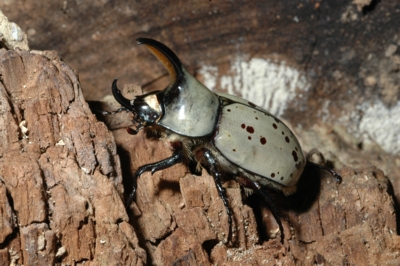
Male Western Hercules Beetle. Click here
to see a larger picture. (U.
Savali, 2006) |
|
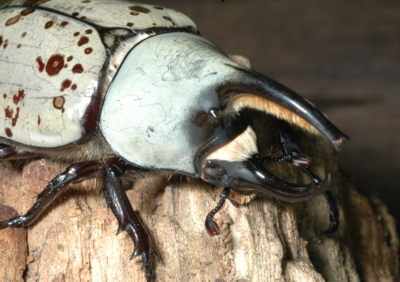
Male Western Hercules Beetle. Click
here to see a larger picture. (U.
Savali, 2006) |
|
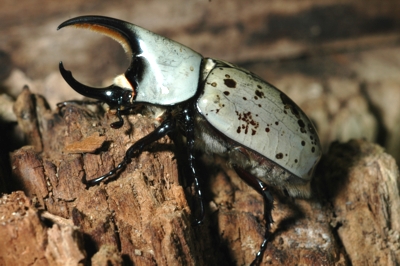
Male Western Hercules Beetle. Click
here to see a larger picture.
(U. Savali,
2006) |
| |
| The Ox
Beetle (Strategus aloeus) belongs to the same subfamily
(Dynastinae) as the Eastern Hercules Beetle. It is found all
over the southern united states, but is not common in Kentucky. Adults
are very strong flyers and are "photophilic" (attracted
to lights). They can be reared in the same way as the Eastern
Hercules Beetle, except that the larvae are cannibalistic and must
be housed singly. A male ox beetle is shown below. |
|
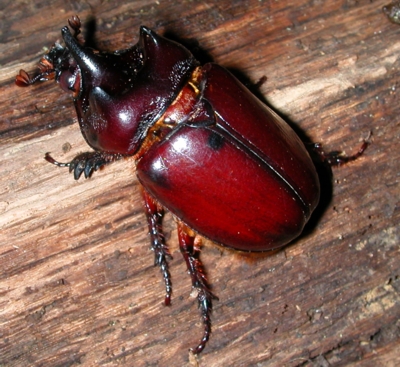
Ox Beetle (U.
Savali, 2006) |
| |
| HYDRIDIZATION: Eastern+Western Hercules Beetles |
|
In 2002, Bill Wallin captured larvae of the Western Hercules beetle. When these emerged as adults, Wallin mated the Western males with Eastern Hercules Beetle females. The hybrid progeny emerged as adults in Fall/Winter 2007. Read more and see pictures of the hybirds here. |
| |
| HERCULES
BEETLE LINKS |
|
Although
we only have one kind of Hercules beetle in Kentucky, there are
many other kinds of Hercules and Rhinoceros beetles in the world.
Some of them are very large. Read more about some of them at the
Rhinoceros Beetle page:
http://www.angelfire.com/ns/RhinocerosBeetles/
|
| |
|
|
| |
| MYTHS
- LEGENDS - FOLKLORE |
|
Because of their large
size and impressive horns, many people believe that Hercules beetles
are dangerous. In fact, their horns are not dangerous at all,
and the beetles are not known to bite. However, if you pick
one up, it may scratch you with its strong, spiny legs. |
| |
Original document: 25 May 2004
Last updated: 7 Mar 2008
Photos courtesy R.
Bessin, B. Wallin, U. Savali, and B. Newton, University of Kentucky
The Kentucky Critter Files are maintained by Blake Newton, Department
of Entomology, University of Kentucky.
Contact: blaken@uky.edu |
|

